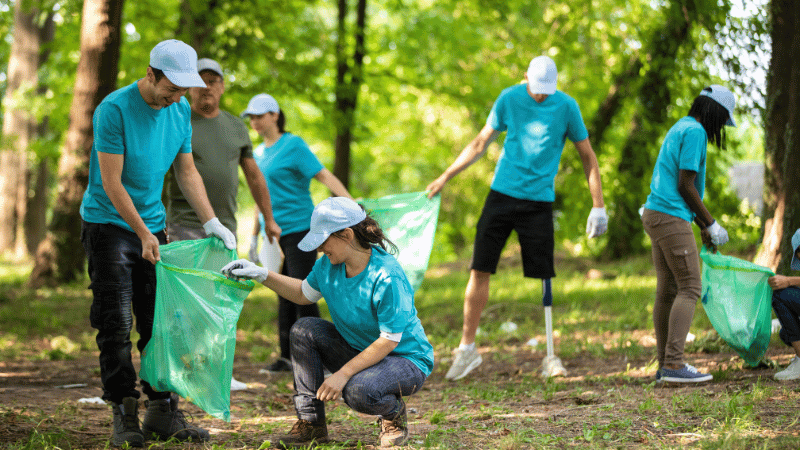Over one billion people worldwide embrace volunteerism, and 64 million are American. 25% of the national adult population – one in four people – willingly contributes their time, skills, and resources to support organizations that align with their personal beliefs.
Whether lending a hand in local community-led organizations or participating in global humanitarian efforts, volunteers play a vital role in addressing societal challenges. Keep reading to learn more about volunteerism, the different roles volunteers play, and its impact on organizations, communities, and society.
Defining Volunteerism for Modern Nonprofits
In today’s dynamic landscape of social responsibility and community engagement, volunteerism stands out as a cornerstone in the foundation of modern nonprofits. It represents more than just acts of service; it’s a commitment to making a tangible difference in the world.
Volunteers are invaluable resources for nonprofits. They provide essential support with fundraising efforts, program delivery, advocacy, and outreach.

The Significance of Volunteerism
Mahatma Gandhi famously said, “The best way to find yourself is to lose yourself in the service of others.”
Essentially, this is what volunteerism is – a powerful force for change, capable of transforming individuals, communities, and societies. Its significance lies in its ability to mobilize collective action, inspire hope, and create a more just, equitable, and sustainable world for all.
Here are some key reasons why volunteerism is significant:
- It fosters social cohesion by bringing people together across diverse backgrounds, beliefs, and experiences. It promotes a sense of belonging and community, bridging divides and building connections between individuals and groups.
- It empowers individuals to take action and make a difference in their communities. By giving their time, skills, and resources, volunteers exercise agency and contribute to shaping the world around them.
- It plays a crucial role in addressing social inequality and injustice by amplifying the voices of marginalized communities, advocating for policy change, and providing support to those in need.
- It contributes to building resilient communities capable of overcoming adversity and bouncing back from challenges. Through their collective efforts, volunteers strengthen social networks, promote cooperation, and enhance community preparedness and response.
- It promotes civic engagement by encouraging individuals to participate actively in the democratic process and contribute to the common good. It instills a sense of civic responsibility and encourages individuals to actively shape their communities and society.
- It transcends borders and promotes global solidarity and cooperation. Volunteers engage in international humanitarian efforts, support global development initiatives, and build bridges between cultures and nations.
How Volunteerism Strengthens Organizations
Volunteers enrich nonprofit organizations by building capacity, contributing to the skills and diversity of the organization, and assisting with community engagement.
1. Expanding Capacity
Often, nonprofits struggle to meet the many demands that come with realizing their mission, which can place strain on their organizational capacity. By filling essential roles and functions, such as administrative support, program delivery, and event coordination, volunteers can help alleviate much of that strain. Volunteers allow organizations to operate more efficiently and effectively, maximizing the resources available for advancing their missions.
2. Diverse Perspectives
Volunteers bring a wealth of diverse perspectives, experiences, and skills to nonprofit organizations, enriching the work environment and fostering innovation. By engaging volunteers from different backgrounds and expertise areas, organizations can tap into fresh ideas, creative solutions, and alternative approaches to addressing complex challenges.
3. Community Engagement
Whether an organization has a local community-focused mission or a more far-reaching one, it will always need ambassadors and advocates. Enlisting volunteers to raise awareness, generate support, and build connections cultivates a sense of community.
Volunteer Roles in Nonprofit Organizations
In the vibrant ecosystem of nonprofit organizations, volunteers play an indispensable role in driving mission fulfillment and community impact. Beyond their sheer numbers, volunteers hold roles that are instrumental in the success of nonprofits. From frontline service delivery to strategic planning, they contribute their time, skills, and passion across a spectrum of functions.
Here are just a few examples of roles volunteers could play in your organization.
- Direct service providers: This could include roles such as tutors for educational programs, mentors for youth initiatives, caregivers for senior services, or counselors for crisis intervention programs.
- Event coordinators: They may help with event logistics, marketing and promotion, participant registration, and on-site coordination to ensure events run smoothly and successfully.
- Administrative support: They help streamline operations and ensure the efficient functioning of the organization’s administrative processes.
- Board members: Board members play a crucial role in setting the organization’s direction, ensuring compliance with legal and ethical standards, and representing the interests of stakeholders.
- Fundraisers: They may help solicit donations, steward donors, plan fundraising events, and assist with grant writing and donor communications to support the organization’s financial sustainability.
- Community ambassadors: They represent the organization at community events, speak on behalf of the organization, and engage with stakeholders to promote its mission and programs.

Volunteer Recruitment & Retention
You know that volunteers are the unsung heroes of the nonprofit world, providing invaluable support, dedication, and passion to advance the missions of organizations worldwide. But how do you ensure your organization meets volunteerism best practices for finding, onboarding, and retaining top volunteers?
1. Finding Good Volunteers
Many organizations struggle to find and retain great volunteers. Let’s walk through a few key steps to consider when it comes to volunteer recruitment and retention to help your organization build the best volunteer program possible.
- Targeted recruitment: Tailor recruitment efforts to reach individuals who align with the organization’s values, interests, and skill sets. Utilize online platforms, social media, community events, and partner organizations to expand outreach.
- Clear communication: Communicate volunteer opportunities, expectations, and impact to prospective volunteers through compelling storytelling, engaging content, and transparent communication channels.
- Networking and partnerships: Leverage existing networks, partnerships, and referral programs to tap into pools of potential volunteers who are already engaged or connected with the organization’s cause.
2. Onboarding Volunteers
Onboarding volunteers effectively sets the stage for a successful and fulfilling experience. Here’s how nonprofits can ensure a smooth transition for new volunteers:
- Orientation and training: Provide comprehensive orientation sessions and training opportunities to familiarize volunteers with the organization’s mission, values, and procedures.
- Role clarity: Clearly define volunteer roles, responsibilities, and expectations. This ensures volunteers understand their contributions and how they fit into the organization’s overall objectives.
Pro tip: Establishing a strong volunteer onboarding process will help your organization retain its best volunteers.
3. Retaining Your Best Volunteers
Retaining top volunteers is essential for nonprofits to maintain continuity, build relationships, and sustain impact. Here’s how organizations can cultivate a culture of retention:
- Recognition and appreciation: Acknowledge and celebrate the contributions of volunteers through personalized thank-you notes, recognition events, and awards programs. Show genuine appreciation for their time, effort, and dedication.
- Professional development: Offer opportunities for skill development, growth, and leadership within the organization. Provide training workshops, networking events, and mentoring opportunities to empower volunteers to expand their capabilities and responsibilities.
- Feedback and engagement: Solicit feedback from volunteers regularly to understand their experiences, preferences, and suggestions for improvement. Foster open communication and dialogue to ensure volunteers feel valued, heard, and engaged in the organization’s decision-making processes.
Conclusion
As we reflect on volunteerism, we must recognize the countless individuals who dedicate their time, skills, and resources to making a difference.
Whether through direct service, advocacy, or community building, each volunteer plays a valuable role in creating a brighter and more compassionate future for generations to come.
They may also be the difference between you serving 50 vs. 500 beneficiaries, or your nonprofit raising $500 vs. $5,000. Investing in your volunteer program can translate to your organization meeting the needs of meeting the needs of thousands and realizing your mission.
With simple-to-use and affordable fundraising features such as Crowdfunding, Peer-to-Peer, Memberships, Events, Text-to-Give, Recurring Donation Forms, and more, Donorbox is always there for you and your volunteer superstars. Learn about all of our comprehensive features here and sign up today!
Feel free to check out our Nonprofit Blog for tips and resources to help your nonprofit, and subscribe to our newsletter to receive a curated collection of blogs in your inbox every month!






